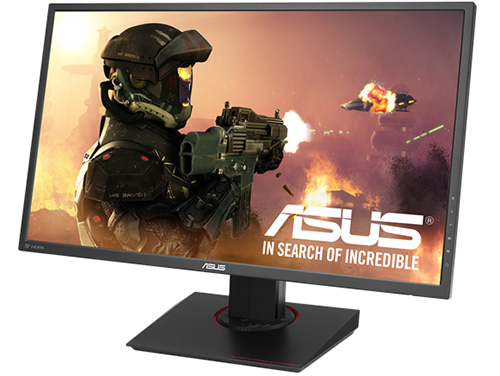ASUS Announces A 144Hz WQHD Gaming Monitor With FreeSync
by Brandon Chester on August 19, 2015 12:59 PM EST
Today ASUS announced a new monitor targeted at the gaming market. The ASUS MG278Q is a 27" TN panel with a resolution of 2560x1440 and a 144Hz refresh rate. In the chart below you can see further information about the monitor and its specifications.
| ASUS MG278Q | ||||||
| Resolution | 2560x1440 | |||||
| Refresh Rate | 144Hz | |||||
| Panel Size | 27" | |||||
| Peak Brightness | 350nits | |||||
| Response Time | 1ms (GtG) | |||||
| Viewing Angle (H/V) | 170° / 160° | |||||
| Inputs / Outputs | 1 x DisplayPort 1.2 1 x Dual-link DVI 1 x HDMI 2.0 1 x HDMI 1.4 1 x 3.5mm audio 3 x USB 3.0 (1 upstream 2 downstream) |
|||||
| Color Depth | 16.7 million colors (Likely 6bit+AFRC) | |||||
| Dimensions | 625 x 563 x 233mm (with stand) | |||||
Being a gaming-oriented display, the MG278Q's focus is on a low response time and a high refresh rate rather than color accuracy. Since it's a TN panel it's likely that the panel has a native 6bit color depth per subpixel and uses temporal dithering to emulate 16.7 million colors, although this has not been confirmed. In addition to the 144Hz refresh rate, the MG278Q supports AMD's FreeSync technology which utilizes the Adaptive Sync feature of DisplayPort 1.2a to enable a variable refresh rate synchronized to the GPU's rendering of frames. More information about FreeSync and how it works can be found here.
ASUS is yet to announce pricing fort he MG278Q, but we've seen TN displays with similar specifications from Acer and BenQ for $500-600. The MG278Q will be available in North America in early September
Source: ASUS










59 Comments
View All Comments
BurntMyBacon - Friday, August 21, 2015 - link
See Response Time and Lag sections:http://www.tftcentral.co.uk/reviews/acer_xb270hu.h...
http://www.tftcentral.co.uk/reviews/asus_mg279q.ht...
The electronics can most definitely be made faster for IPS and IPS does make sense at 144Hz. You are correct in your assertion that TN will usually also benefit from these advances and will likely remain faster than IPS for the foreseeable future. The question is at what point do I cease to notice / care about the difference. When do other considerations dominate?
TristanSDX - Wednesday, August 19, 2015 - link
Do FreeSync make sense ? AMD GPU market share is low and still shrinking.medi03 - Wednesday, August 19, 2015 - link
40% last time I've checked on Steam.That's certainly negligible market share.
And why support Freesync for free when you could drop all ports but one DP, make your monitor 120$ more expensive and support nVidias proprietary crap?
Decisions decisions.
Salvor - Wednesday, August 19, 2015 - link
You haven't looked in a while it seems: I just checked steam stats: 52.47% nVidia, 19.69% intel, 27.34% AMD/ATI, 0.5% other. Fury was nice but repeated rebrands in the mid range has been hurting them a bit I think. Price/performance is still generally fine and better than nvidia in many cases, but people like new cards.RussianSensation - Wednesday, August 19, 2015 - link
Intel plans to support VESA Adaptive-Sync displays (aka AMD's FreeSync).http://techreport.com/news/28865/intel-plans-to-su...
That means 85% of the entire graphics card market will benefit from a FreeSync monitor. It's about time NV stops being greedy with their proprietary tech and offers consumers options to buy a joint GSync+FreeSync monitor if they so desire, which also requires that their GPUs support FreeSync as well.
http://jonpeddie.com/images/uploads/publications/P...
http://jonpeddie.com/publications/market_watch/
Hxx - Wednesday, August 19, 2015 - link
Here is hoping that it will be about $300 because thats how much these TN panels are worth especially since freesync is free.MrSpadge - Wednesday, August 19, 2015 - link
When WQHD monitors with 25" came out (e.g. Dell) I thought "wow, the perfect compromise between high-DPI and no scaling". Bought one and really love it! Just using 110% or 120% scaling in Firefox for longer reading and/or especially small text.looper - Wednesday, August 19, 2015 - link
This Eizo is the best gaming monitor out there, IMHO.http://gaming.eizo.com/products/foris_fg2421/
trab - Thursday, August 20, 2015 - link
Having owned both the ASUS ROG Swift PG278Q and no the Acer Predator XH270HU, I would definitely want IPS and less ridiculous anti glare coatings any day.The PG278Q is far too bright on the lowest brightness setting (excluding ULMB) and the contrast pales in comparison.
On the XB270HU I don't notice the IPS glow that much to be honest, unless the screen is totally blank, the reduction in anti glare coating more than makes up for it.
I may be a little biased of course, I had to get the PG278Q serviced after 6 months after it completely failed. ASUS replaced the panel once it was still broken then couldn't get me a reasonable time frame for another, so I waited until I could get the XB270HU.
I don't notice motion blur much at all, in fact it seems better than the PG278Q because of the "screen door" artifacting at high frame rates that occured.
Only have one dead pixel on my XB270HU (far left), the replacement (but faulty) PG278Q panel also had one somewhere.
Then there is the old TN vertical viewing angle issue which I could not eliminate no matter what angle the screen was to me, rather has IPS glow any day.
rxzlmn - Thursday, August 20, 2015 - link
Is there a specific reason why monitors come with a relatively odd refresh rate of 144 Hz? I know there are 120 Hz monitors too, but most are 144 Hz (and obviously it's better since higher). Why isn't it simply 150 or 180 Hz?